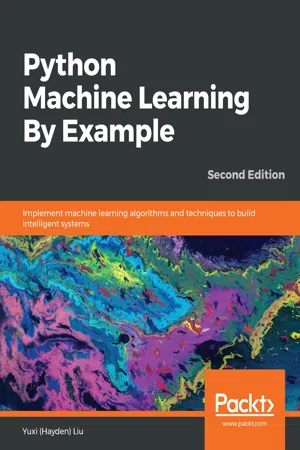
Python Machine Learning By Example
Implement machine learning algorithms and techniques to build intelligent systems, 2nd Edition
Yuxi (Hayden) Liu
- 382 pagine
- English
- ePUB (disponibile sull'app)
- Disponibile su iOS e Android
Python Machine Learning By Example
Implement machine learning algorithms and techniques to build intelligent systems, 2nd Edition
Yuxi (Hayden) Liu
Informazioni sul libro
Grasp machine learning concepts, techniques, and algorithms with the help of real-world examples using Python libraries such as TensorFlow and scikit-learn
Key Features
- Exploit the power of Python to explore the world of data mining and data analytics
- Discover machine learning algorithms to solve complex challenges faced by data scientists today
- Use Python libraries such as TensorFlow and Keras to create smart cognitive actions for your projects
Book Description
The surge in interest in machine learning (ML) is due to the fact that it revolutionizes automation by learning patterns in data and using them to make predictions and decisions. If you're interested in ML, this book will serve as your entry point to ML.
Python Machine Learning By Example begins with an introduction to important ML concepts and implementations using Python libraries. Each chapter of the book walks you through an industry adopted application. You'll implement ML techniques in areas such as exploratory data analysis, feature engineering, and natural language processing (NLP) in a clear and easy-to-follow way.
With the help of this extended and updated edition, you'll understand how to tackle data-driven problems and implement your solutions with the powerful yet simple Python language and popular Python packages and tools such as TensorFlow, scikit-learn, gensim, and Keras. To aid your understanding of popular ML algorithms, the book covers interesting and easy-to-follow examples such as news topic modeling and classification, spam email detection, stock price forecasting, and more.
By the end of the book, you'll have put together a broad picture of the ML ecosystem and will be well-versed with the best practices of applying ML techniques to make the most out of new opportunities.
What you will learn
- Understand the important concepts in machine learning and data science
- Use Python to explore the world of data mining and analytics
- Scale up model training using varied data complexities with Apache Spark
- Delve deep into text and NLP using Python libraries such NLTK and gensim
- Select and build an ML model and evaluate and optimize its performance
- Implement ML algorithms from scratch in Python, TensorFlow, and scikit-learn
Who this book is for
If you're a machine learning aspirant, data analyst, or data engineer highly passionate about machine learning and want to begin working on ML assignments, this book is for you. Prior knowledge of Python coding is assumed and basic familiarity with statistical concepts will be beneficial although not necessary.
Domande frequenti
Informazioni
Section 1: Fundamentals of Machine Learning
- Chapter 1, Getting Started with Machine Learning and Python
Getting Started with Machine Learning and Python
- Overview of machine learning and the importance of machine learning
- The core of machine learning—generalizing with data
- Overfitting
- Underfitting
- Bias variance trade-off
- Techniques to avoid overfitting
- Techniques for data preprocessing
- Techniques for feature engineering
- Techniques for model aggregation
- Software installing
- Python package setup
Defining machine learning and why we need it




Indice dei contenuti
- Title Page
- Copyright and Credits
- About Packt
- Dedication
- Foreword
- Contributors
- Preface
- Section 1: Fundamentals of Machine Learning
- Getting Started with Machine Learning and Python
- Section 2: Practical Python Machine Learning By Example
- Exploring the 20 Newsgroups Dataset with Text Analysis Techniques
- Mining the 20 Newsgroups Dataset with Clustering and Topic Modeling Algorithms
- Detecting Spam Email with Naive Bayes
- Classifying Newsgroup Topics with Support Vector Machines
- Predicting Online Ad Click-Through with Tree-Based Algorithms
- Predicting Online Ad Click-Through with Logistic Regression
- Scaling Up Prediction to Terabyte Click Logs
- Stock Price Prediction with Regression Algorithms
- Section 3: Python Machine Learning Best Practices
- Machine Learning Best Practices
- Other Books You May Enjoy